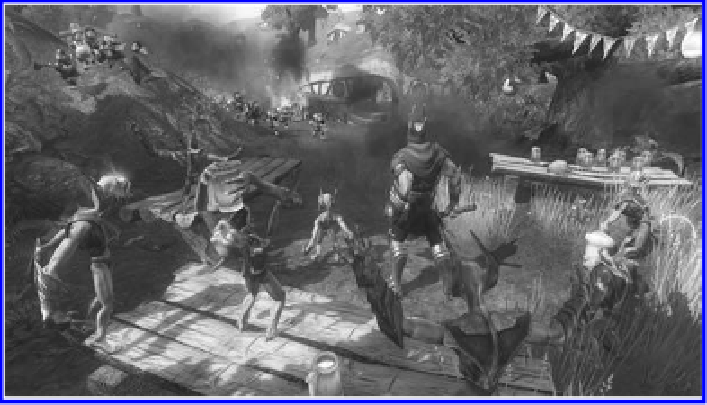Game Development Reference
In-Depth Information
Figure 14.2.
Ransacking cute villages and setting fire to halflings proved to be very popular in
the
Overlord
world.
opment for a year. The basic story of this action-adventure title was that the player
assumed the role of a newly appointed evil overlord tasked with bringing the smit-
ing stick down hard upon the seven heroes who killed their predecessor and looted
their dark tower. The gameplay premise, namely that the player would use an ever-
expanding army of gremlin-like minions to do their evil (and not so evil) deeds, was
already pretty solid and fun to play.
Many of the levels were already in development and had been designed around
the fall of the seven heroes, who had fallen from grace in the manner of the seven
deadly sins. So the halfling hero (who represented greed) had eaten himself into this
disgusting blob, enslaving the inhabitants of his realm to perpetual food-farming in
the process. Meanwhile, the holy Paladin's trips to the local brothel and weakness for
succubi had caused a city-wide plague. He, unsurprisingly, represented lust. You get
the idea.
Although the game itself never shouted about it, the use of deadly sins made a
nice, easy-to-grasp framework for the heroes (handy when explaining things to the
press) and also bled through to the environments and the quest and level
design.
The environments themselves were deliberately quite typical fantasy fare: rolling
green meadows, magical forests, war-torn cities, scorching deserts, and ruined castles.
And since the mood of the game was very tongue-in-cheek, the level design and sheer
exuberant joy of heading up a rampaging horde of angry minions gave the world
more of a dark twist, as much in gameplay action as in looks. So the player could
well find themselves setting fire to halflings, performing genocide on the elven race,
battling drunken dwarves, and generally giving the good, bad, and ugly of fantasy
land a good, solid thrashing.

















Search WWH ::

Custom Search